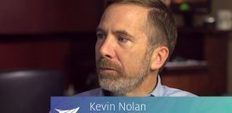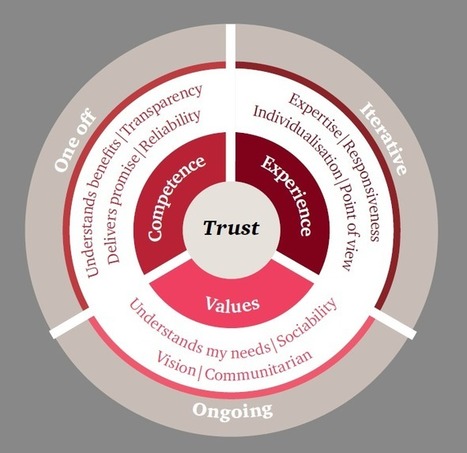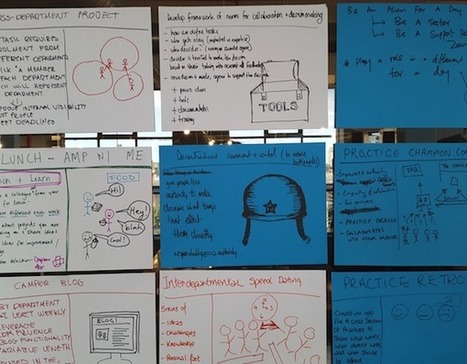 Your new post is loading...
 Your new post is loading...

|
Scooped by
Andrew Gerkens
April 18, 2018 6:56 PM
|
You’ll rarely meet a CEO or top executive suggesting, “What we need to do is slow down.” This counter-intuitive guidance in a world seemingly spinning faster-and-faster flies in the face of conventional thinking and practice, yet in matters of strategy, slowing down to move faster, is often the recipe for success.

|
Scooped by
Andrew Gerkens
April 11, 2018 11:26 PM
|
I’m not talking about buying guest towels or renters insurance. I’m talking about how we ought to be developing in adulthood. How should we be perceiving and engaging with the world? Or handling…

|
Scooped by
Andrew Gerkens
April 11, 2018 11:12 PM
|
More and more companies today are facing adaptive challenges: Changes in societies, markets, and technologies around the globe constantly force businesses to clarify their values, develop new strategies, and learn new ways to operate. The most important task for leaders in the face of such challenges is mobilizing people throughout their organizations to do adaptive work.

|
Scooped by
Andrew Gerkens
April 11, 2018 7:50 PM
|
In an increasingly automated workplace, leaders should concentrate on uniquely human skillsets.

|
Scooped by
Andrew Gerkens
April 11, 2018 1:39 AM
|
You need four things to do it.

|
Scooped by
Andrew Gerkens
April 11, 2018 1:33 AM
|
If you’re a CEO, how could a better understanding of organizational culture help you? Conversely, how can the inability to manage or change culture hold the business back? During a recent gathering of CEOs and board directors in Chicago, we kicked off a discussion about culture and business performance with a simple question: How does the topic of culture come up at the board level or with your executive team today?
The responses reflected the breadth of strategic and business challenges that CEOs and their teams face today, including:
- Aligning the organization around a transformation agenda
- Innovating for the future while maintaining strong execution today
- Integrating teams and organizations in a merger or acquisition
- Effectively managing a changing workforce
- Building organizational support for a new CEO
- Bringing customers along with new processes or offerings
Our discussion with CEOs and board directors underscored why it’s so important for leaders to manage and shape culture today. Here are five takeaways from our discussion.
Culture should be viewed as a foundational business system and managed as such.
Amid the unprecedented volatility, uncertainty, complexity, ambiguity and pace of change facing organizations, culture plays an important role in helping organizations adapt to emerging challenges. It’s not enough for leaders to rely on strategy, structure and processes to manage the business because they don’t adequately address the people side of the change equation. But the right culture allows companies to coordinate activities across very big, complex organizations very quickly. Organizations that embrace the same sort of management discipline around culture as they do for other key performance levers like strategy and financial operations will be best positioned to shape culture to support emerging needs. Ideally, conversations about culture will be integrated into the natural flow of the business — during regular management team meetings, the annual strategy session and other follow-up strategy discussions.
Managing culture requires a definition and a model.
It’s not unusual for “culture” to become a catch-all for everything people don’t like about an organization, or for people to think about culture in terms of the outcomes they want to achieve — say, a customer-focused culture. But this isn't that helpful, because customer focus at Google will look very different than at Goldman Sachs or Disney. To understand culture, we need to look deeper at the underlying social system that directs the organizational behaviors that lead to specific outcomes. We define culture as the shared assumptions that drive the way organizations think, behave and act. Culture is pervasive; whether leaders acknowledge it or not, it's everywhere. Executives have an opportunity to either shape culture or allow it to shape them.
To shift the culture, you first have to be able to articulate what the culture is today and whether it supports your strategic priorities. Our culture model allows us to identify the underlying shared assumptions that are most influential in the organization and how they are guiding the way the organization thinks, behaves and acts — and how those assumptions align with stated strategy.
Start from the outside-in when setting a target culture.
When working with organizations to define a target culture, we recommend starting with the external trends that will affect the business. What regulatory, competitive and customer trends drive what the organization needs to do? We also look at the company’s strategic direction, as well as its heritage, history and current culture. Finally, we consider the kind of culture that would motivate and draw out the best of the current workforce. These data points serve as inputs for business leaders in making a data-based decision about what that target culture should be and how they can align their people around it.
Culture and leadership are inextricably linked, so select and develop leaders who support the culture you want.
The style of the management team — especially the CEO — the way they behave and communicate, what they focus on in meetings, the questions they ask and the people who they hire, recognize and promote all send signals about the culture and how to succeed in it. That’s why when you’re trying to shape culture, leaders play a central role in setting the tone and changing habits. A very aggressive, results-focused culture, for example, will bring out those behaviors in leaders or push out people who don’t like that culture. An important part of shifting culture in a certain direction, then, is leadership selection — who is in what roles and the models they set. The most effective culture change leaders are credible in the current culture, but are able to help push the culture in the desired direction.
Boards overlook an important area of risk and performance oversight if they aren’t asking about culture.
A company’s culture can make or break even the most insightful strategy or the most experienced executives. Cultural patterns can produce innovation, growth, market leadership, ethical behavior and customer satisfaction. On the other hand, an unhealthy or misaligned culture can impede strategic outcomes, erode business performance, diminish customer satisfaction and loyalty, and discourage employee engagement. Boards should consider whether they have an adequate line of sight on the culture and understand the cultural fluency and impact of the management team. In addition to assessing any potential risks the culture could pose, boards also will want to incorporate thinking about culture into forward-looking activities such as CEO succession planning.
***
When there is a need to shift the culture, it’s tempting to focus on all the ways the current culture isn’t working or focus energies on short-term initiatives or one-day workshops. But absent a framework and ongoing management discipline around culture, the organization is likely to quickly fall back into familiar habits and cultural patterns. Our research has shown that culture can be managed and shaped by diagnosing the current culture; defining a target culture that aligns with the needs of the business; selecting and developing leaders with culture in mind; gaining buy-in for the target culture through structured conversations across the organization; and ensuring that performance management, training, compensation and other systems and processes support the ideal culture.

|
Scooped by
Andrew Gerkens
April 11, 2018 1:28 AM
|
When we talk about the future of work, we talk about managing learning, creativity, uncertainty and complexity as human roles. The processes, the predictable and routine will be automated. What we do…

|
Scooped by
Andrew Gerkens
February 6, 2018 1:37 AM
|
Network perspective is a 21st-century leadership imperative. Network perspective is the ability to look beyond formal, designated relationships and see the complex web of connections between people in and beyond (More)

|
Scooped by
Andrew Gerkens
January 8, 2018 9:03 PM
|
Too often we think that changing leaders is about putting things into the leader’s practice—new skills, new understandings, new behaviors. The piece we often miss is that for leaders to be transformational, they also need to be transforming themselves. But how?

|
Suggested by
vamsipriya pagadala
December 28, 2017 1:07 AM
|
The fact is that many employees do not satisfy the expectation of the employers and hence they are subject to immediate disciplinary action. Such employees are placed in a performance improvement plan (PIP). When higher officials find out that an employee is under performing certain area then a performance improvement plan would be helpful to …

|
Rescooped by
Andrew Gerkens
from Personal Learning
December 10, 2017 5:29 PM
|
Research suggests that managers need to become coaches to get the best out of their employees.
Via Helen Blunden

|
Scooped by
Andrew Gerkens
November 28, 2017 1:42 AM
|

|
Scooped by
Andrew Gerkens
October 30, 2017 5:57 PM
|
Are you looking for a way to take action on employee feedback quickly and effectively? Learn how from Culture Amp Customer Success Coach Monique Hughes.
|

|
Scooped by
Andrew Gerkens
April 17, 2018 10:16 PM
|
What if organizations, by being places where our lives could be lived in orderly and predictable ways, have been making us more fragile for these last decades? How could organizations shift towards shaking things up often enough to keep us strong, but not so often that they break the useful boundaries and make us weaker?

|
Scooped by
Andrew Gerkens
April 11, 2018 11:20 PM
|
Leaders are made, not born, and how they develop is critical for organizational change.

|
Scooped by
Andrew Gerkens
April 11, 2018 10:37 PM
|
The work of cultural transformation is deeply complex with a great deal of uncertainty and ambiguity. While it is essential for any transformation to be championed and role modelled from the top, it also requires a strong network of people at multiple levels within and across an organisation to be able to sustain significant change. This article identifies how you can build momentum through developing a powerful network of advocates.

|
Scooped by
Andrew Gerkens
April 11, 2018 1:44 AM
|
Allowing people and teams to connect and interact

|
Scooped by
Andrew Gerkens
April 11, 2018 1:37 AM
|
The personal growth of leaders and culture practitioners is one of the central themes of the Adaptive Cultures approach. We have found that as leaders and culture practitioners deepen their personal growth, they exponentially increase their capacity to influence the systems they work within.

|
Scooped by
Andrew Gerkens
April 11, 2018 1:31 AM
|
How is it that busy people can make significant changes? Is it possible that leaders can actually get too busy to develop?

|
Scooped by
Andrew Gerkens
February 15, 2018 1:24 AM
|
How can leaders translate strategic complexity into simple and flexible guidelines that get results?

|
Scooped by
Andrew Gerkens
January 19, 2018 12:14 AM
|
To compete at the speed of digital, you need to unleash your strategy, your structure, and your people.

|
Scooped by
Andrew Gerkens
December 28, 2017 1:10 AM
|
To live authentically, you must own your actions and ensure that they align with your beliefs and needs. This can be a difficult thing to maintain when external forces pressure you to do something you’re not comfortable with or to be someone you’re not.

|
Scooped by
Andrew Gerkens
December 26, 2017 6:38 PM
|
Organisations spend a lot of time talking about values. They spend less time exploring their use in practice. The most dangerous for corporate values is rarely an attack on the heart of a value. Corporate values collapse not because of direct attack but by creeping conflict at the edges that create a culture of corruption.…

|
Scooped by
Andrew Gerkens
November 30, 2017 1:26 AM
|
Effective leadership often means handing projects over to your team members and empowering them to successfully complete them on their own. But what if your employees don’t feel a sense of personal responsibility? A digital workplace can complicate matters further.

|
Scooped by
Andrew Gerkens
October 30, 2017 11:37 PM
|
New research reveals surprising truths about why some work groups thrive and others falter.
|
 Your new post is loading...
Your new post is loading...
 Your new post is loading...
Your new post is loading...

























I'm interested in practical ways for slowing down to speed up, individually and collectively. How do we make time and space to get on the balcony. This article looks at it from a strategy perspective and questions some of our tried and true approaches.
'It’s easy for all of us to become drunk on the adrenaline rush from the need to move faster. However, for many key issues, speed kills'.